2. 中国水产科学研究院黄海水产研究所 山东 青岛 266071;
3. 崂山实验室海洋生态与环境科学功能实验室 山东 青岛 266237
2. Yellow Sea Fisheries Research Institute, Chinese Academy of Fishery Sciences, Qingdao 266071, China;
3. Laboratory for Marine Ecology and Environmental Science, Laoshan Laboratory, Qingdao 266237, China
重金属被认为是海洋环境中的主要污染物之一,因其具有高富集性和难降解性,会在生物体内积累并通过食物链传递,从而引发海洋生物资源的污染问题(Chen et al, 2022; Zhang et al, 2015b)。海洋中的重金属主要来源于陆源排放、大气沉降以及自然释放,尤其以陆源排放为主要的污染源(Gao et al, 2014)。重金属进入海水后,一部分沉降至海底沉积物中,并通过再悬浮过程重新进入水体;另一部分则会溶解在海水中,被海洋生物吸收,并在生物体内富集和转化,进而通过食物链在生物体内进一步积累(Pan et al, 2012)。当海洋生物体内的重金属含量达到一定水平时,可能引发生长缓慢、代谢障碍等不良影响,甚至可能导致畸形或死亡等后果。此外,人们食用含有过量重金属的海产品也会面临中毒和致癌等风险,危害人体健康(魏思翔, 2022)。
渤海是我国唯一的半封闭型内海,包括渤海中部以及渤海湾、莱州湾和辽东湾3个海湾,具有重要的生态和经济价值。环渤海经济圈在工业化和城市化进程中,向渤海输入了大量的重金属(张桂成等, 2023)。研究表明,径流输入是渤海中重金属的主要来源,黄河、海河、辽河、滦河等河流携带着重金属直接注入渤海(Gao et al, 2014)。大气沉降也是渤海重金属的重要来源,研究者通过重金属模拟分析得出,大气沉降是Pb进入渤海和北黄海的主要途径(Liang et al, 2018)。由于渤海是半封闭内海,海水交换和自净能力有限,因此,渤海重金属污染问题日益加剧,并成为重金属污染的热点研究区域(Li et al, 2015)。
作为我国的传统渔场之一,渤海还是多种重要经济渔业生物的产卵场和索饵场,为环渤海城乡居民提供了丰富的食用水产品。渤海的重金属污染问题,也引发了研究者对海产品食品安全和人体健康风险的关注。本研究测量了渤海10种经济鱼类中重金属(Cu、Zn、Pb、Cd、Cr和As)的含量,运用单因子污染指数法(single factor index, SFI)、内梅罗综合污染指数法(Nemerow composite pollution index, NPI)和金属污染指数法(metal pollution index, MPI)评价鱼类受重金属污染程度,同时运用每日摄入量(daily intake, DI)和目标危害系数法(target hazard quotient, THQ)评估渤海鱼类的食用安全风险。研究结果有助于加深了解渤海渔业生物的重金属污染状况,同时为保障渤海水产品的食用安全提供科学依据。
1 材料与方法 1.1 样品采集鱼类样本于2019年12月采集自渤海,采样区域和站位如图 1所示。在每站使用底拖网采集渔业生物,随机选取了10种144条鱼类样本,测量其体长和体重。这10种鱼是常见的食性和生活环境不同的鱼类,具有较高的经济价值。所有鱼类样本均冻存于–20 ℃,直到进一步分析重金属含量。鱼类物种包括黄鲫(Setipinna taty)、蓝点马鲛(Scomberomorus niphonius)、银鲳(Pampus argenteus)、带鱼(Trichiurus lepturus)、小带鱼(Eupleurogrammus muticus)、鳀(Engraulis japonicus)、短吻红舌鳎(Cynoglossus joyneri)、赤鼻棱鳀(Thryssa kammalensis)、细纹狮子鱼(Liparis tanakae)和方氏云鳚(Enedrias fangi)。
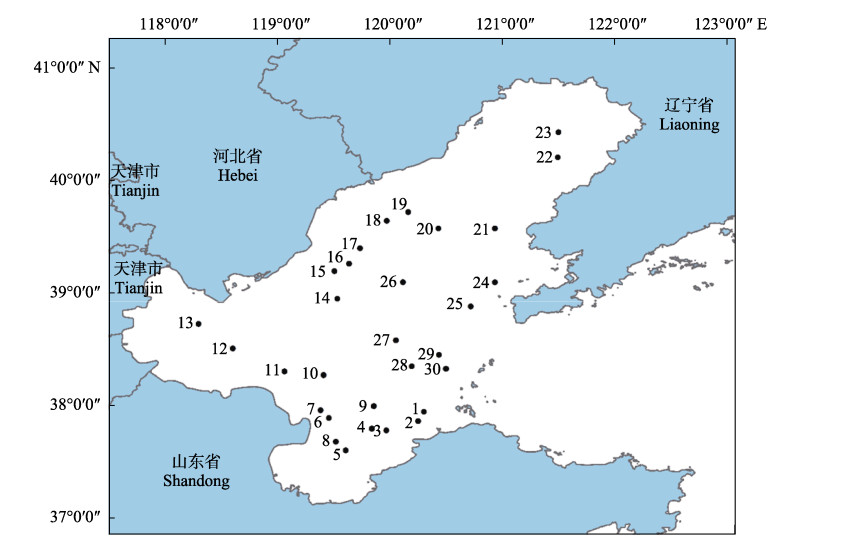
|
图 1 渤海鱼类样本采样站位图 Fig.1 Map depicting sampling stations for Bohai Sea fish samples |
鱼类肌肉中的重金属含量会直接影响人体健康,因此,实验取鱼类肌肉组织,并分析其中重金属Cu、Zn、Pb、Cd、Cr和As的含量。将采集的样本置于室温下解冻,使用陶瓷刀解剖鱼体并收集肌肉组织,将其放入冷冻干燥机中干燥,电子天平(JE2002, 上海)称量,记录所有样本干燥前后的湿重和干重,随后用玛瑙研钵磨碎。称取0.2~0.5 g磨匀后的样品,加入2.5 mL浓H2SO4、4.0 mL浓HNO3和1.5 mL H2O2,然后微波消解。消解过程中,程序升温时间和保持时间分别为10 min (30~90 ℃)和20 min。消解后的样品用超纯水稀释至50 mL,随后使用电感耦合等离子体质谱仪(Inductively coupled plasma mass spectrometry, ICP-MS)(ICAPQ, 美国)测定重金属Cu、Zn、Pb、Cr、Cd和As的含量。
1.3 质量控制ICP-MS测定重金属的标准工作曲线的线性均 > 0.999,平行样品相对标准偏差均 < 4%,加标回收率为80%~120%。为了减少外部因素对实验结果的干扰,所用容器与材料均为高硼硅玻璃或玛瑙陶瓷材质,避免因使用金属材质而带来潜在的污染风险。设置空白对照,除不加入肌肉组织,其他步骤相同。
1.4 鱼类重金属污染评价单因子污染指数法常用于评价某一重金属在鱼体内的污染情况(刘洋等, 2021),公式如下:
| $ {P_i} = \frac{{{C_i}}}{{{S_i}}} $ | (1) |
式中,Pi为重金属i的单因子污染指数,表示某一重金属的污染程度;Ci为重金属i含量的实测值(mg/kg);Si为重金属i的限量值(表 1)。一般认为,Pi≤0.2为无污染;0.2 < Pi≤0.6为轻度污染;0.6 < Pi≤1.0为中度污染;Pi > 1.0为重度污染。
|
|
表 1 鱼类重金属含量限值 Tab.1 Limit of heavy metal content in fish |
在海洋生物体内检测的总As元素中,有机As占比较大,而具有毒性的无机As (iAs)含量相对较少。根据文献资料,iAs占总As的比值介于0.02%~6.88%之间(韩丹丹等, 2018),本研究选择比值6.88%来估算渤海鱼类肌肉中iAs的含量。
内梅罗综合污染指数法整合了多种重金属的污染水平,能够更为全面地反映鱼体受重金属污染的情况(王文君等, 2019)。公式如下:
| $ {P_N} = \sqrt {(P_{avg}^2 + P_{\max }^2)/2} $ | (2) |
式中,PN为内梅罗综合污染指数,Pavg为某一鱼类所有重金属元素单项污染指数平均值,Pmax为某一鱼类所有重金属元素单项污染指数的最大值。评价标准同单因子污染指数法。
金属污染指数法可用于鱼类重金属污染的综合评价(孙玲玲等, 2018)。计算公式为:
| ${\rm{MPI}}=\sqrt[i]{{{C_1} \times {C_2} \times {C_3} \times \cdots \times {C_i}}} $ | (3) |
式中,Ci为样品中第i种重金属的浓度(mg/kg);i为评价元素个数。
1.5 鱼类食用安全性评价为了评估受重金属污染鱼体的食用风险,本研究引入每日摄入量和目标危害系数作为评估指标。
DI评估了每日从鱼类食物中摄入的重金属含量(Copat et al, 2012),计算公式如下:
| $ {\text{D}}{{\text{I}}_i} = \frac{{{\text{FIR}} \times {C_i}}}{{{\text{BW}}}} $ | (4) |
式中,DIi为重金属i的每日摄入量[μg/(kg·d)];FIR为人群每日的鱼类摄入量,根据国家统计局统计数据,2018年我国平均每人摄食鱼类为20 g/d;Ci为鱼类中重金属i的浓度(mg/kg);BW为人群平均体重,本文采用世界卫生组织(WHO)推荐的男女体重平均值60 kg。
THQ法是由美国国家环境保护局(USEPA)提出的一种用于评估人体健康潜在风险的方法,特别是针对食物中摄入污染物的潜在风险。它衡量了由于污染物暴露引起的非致癌风险水平,被研究人员广泛采用(Chien et al, 2002; Storelli, 2008; 薛飞等, 2022)。计算公式如下:
| $ {\text{TH}}{{\text{Q}}_i} = \frac{{({\text{EF}} \times {\text{ED}} \times {\text{FIR}} \times {C_i})}}{{({\text{RFD}} \times {\text{BW}} \times {\text{AT}})}} \times {10^{ - 3}} $ | (5) |
式中,THQi为目标危害系数;EF为暴露频率(365 d/year);ED是暴露时间,以平均寿命为70年计;Ci是鱼体内重金属的浓度(mg/kg);RFD是参考剂量,Cu取0.04 mg/(kg·d),Zn取0.3 mg/(kg·d),Pb取0.004 mg/(kg·d),Cd取0.001 mg/(kg·d),Cr取0.003 mg/(kg·d),As取0.0003 mg/(kg·d) (USEPA, 2016; 王文君等, 2019);AT是非致癌物的平均接触时间(25 550 d)。计算中假定重金属的吸收剂量与摄入剂量相等。计算出的健康风险可分为不同等级:THQ≤1,污染物对暴露人群没有明显健康问题;THQ > 1,存在健康问题,且THQ值越大,污染物对人体健康风险越高(Sadeghi et al, 2020)。
多种重金属暴露下的复合危害系数为多种重金属的THQ之和,计算公式如下:
| $ \mathrm{THQs}=\sum \mathrm{THQ}_i $ | (6) |
式中,THQs为复合重金属危害系数;THQi为单一重金属危害系数。
2 结果与分析 2.1 渤海鱼类重金属含量渤海鱼类黄鲫、蓝点马鲛、银鲳、带鱼、小带鱼、鳀、短吻红舌鳎、赤鼻棱鳀、细纹狮子鱼和方氏云鳚肌肉中Cu、Zn、Pb、Cd、Cr和As的含量均值分别为(0.702±0.680)、(9.697±5.279)、(0.035±0.059)、(0.029±0.035)、(0.093±0.091)和(0.959±0.813) mg/kg (图 2)。其中,Cu和Cd分别在鳀鱼和细纹狮子鱼肌肉中含量最高,Zn在蓝点马鲛、鳀、细纹狮子鱼和方氏云鳚肌肉中出现较高的含量,Pb在带鱼、小带鱼和短吻红舌鳎肌肉中有较高的含量,Cr在方氏云鳚和短吻红舌鳎肌肉中的含量较高,As在短吻红舌鳎和鳀肌肉中出现较高含量。
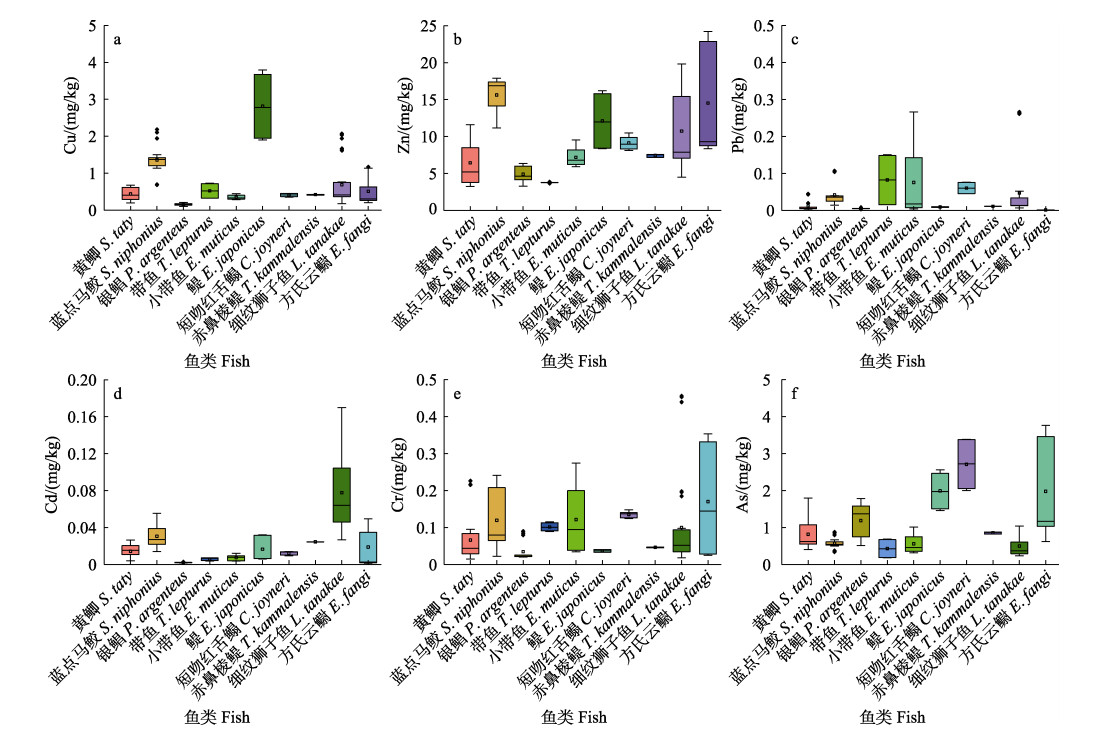
|
图 2 渤海鱼类重金属Cu、Zn、Pb、Cd、Cr和As的含量 Fig.2 The contents of heavy metals Cu, Zn, Pb, Cd, Cr and As in Bohai Sea fish |
渤海鱼类肌肉中重金属单因子污染指数计算结果如图 3所示,Cu、Pb、Cd、Cr和iAs的单因子污染指数范围分别为0.003~0.056、0.003~0.165、0.021~ 0.767、0.017~0.085和0.059~0.373。鳀、短吻红舌鳎和方氏云鳚的iAs单因子污染指数为轻度污染,蓝点马鲛、赤鼻棱鳀和细纹狮子鱼的Cd单因子污染指数分别为轻度污染、轻度污染和中度污染,其余均为无污染。
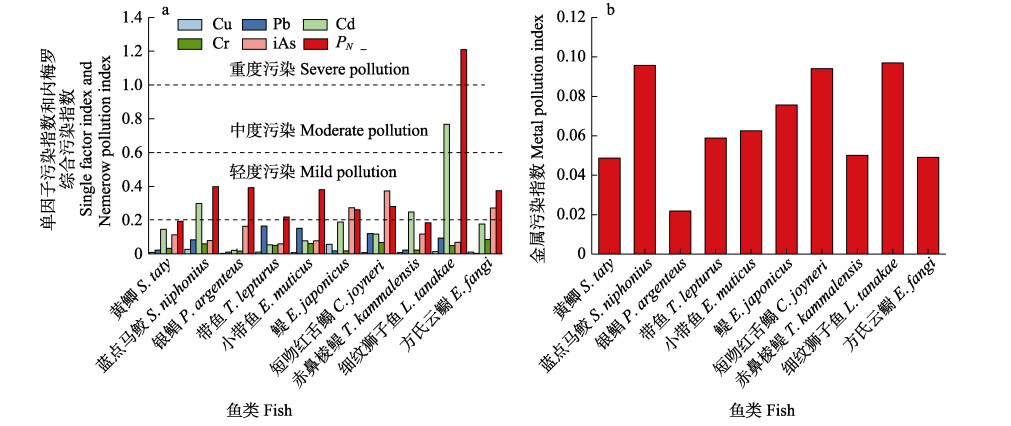
|
图 3 渤海鱼类重金属单因子污染指数、综合污染指数和金属污染指数 Fig.3 Single factor pollution index, comprehensive pollution index and metal pollution index for heavy metals in fish from the Bohai Sea |
进一步计算得出渤海10种鱼类的内梅罗综合污染指数PN。其中,细纹狮子鱼的PN (1.210)值最高,为重度污染水平;黄鲫和赤鼻棱鳀PN (0.193和0.185)最低,为无污染状态。金属污染指数MPI范围为0.022~0.097,蓝点马鲛、细纹狮子鱼和短吻红舌鳎MPI值相近且高于其他种类。
2.3 渤海鱼类食用安全评价本研究以DI和THQ作为渤海鱼类食用安全评价指标。食用渤海所调查的10种鱼类,对于重金属Cu、Zn、Pb、Cd、Cr和iAs的DI如表 2所示。
|
|
表 2 食用渤海鱼类日均摄入重金属的量 Tab.2 Daily intakes of heavy metals from Bohai Sea fish consumption |
据图 4可知,渤海鱼类黄鲫、蓝点马鲛、银鲳、带鱼、小带鱼、鳀、短吻红舌鳎、赤鼻棱鳀、细纹狮子鱼和方氏云鳚的THQs值分别为0.087、0.099、0.102、0.061、0.076、0.200、0.245、0.092、0.096和0.197。10种鱼类单一重金属Cu、Zn、Pb、Cd、Cr和iAs的THQ和多种重金属THQS均 < 1。不同重金属对THQs的贡献有较大差异,渤海鱼类THQ均值依次为Pb(0.002 9) < Cu(0.005 9) < Cd(0.009 8) < Cr(0.010 5) < Zn(0.011 3) < iAs(0.073 3)。
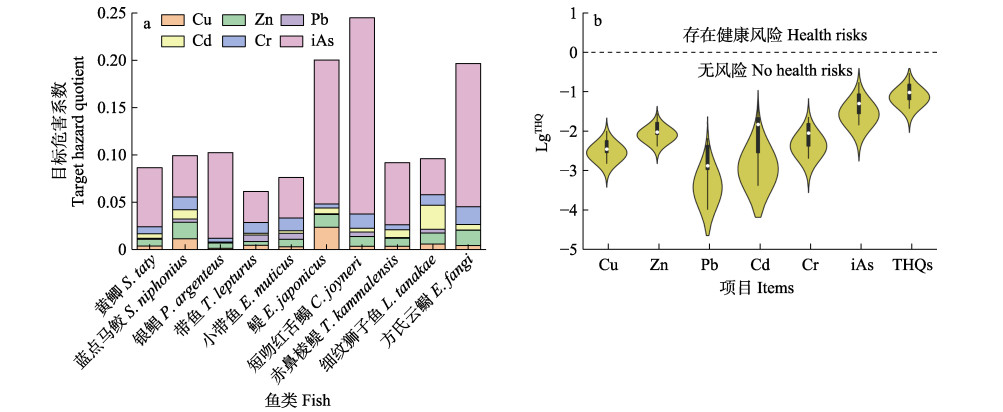
|
图 4 渤海鱼类重金属目标危害系数 Fig.4 Target hazard quotient for heavy metals in fish from the Bohai Sea |
研究结果显示,渤海鱼类重金属的含量水平存在较大差异。具体而言,在10种鱼类肌肉中,Zn的含量明显高于其他元素,而Pb和Cd在鱼类肌肉组织中的含量最低。这与Salam等(2019)的研究结果基本一致。鱼类体内不同重金属的含量差异较大,这可能是因为海洋环境中不同重金属元素的含量差异以及这些重金属在鱼类中的半衰期不同。由于海洋环境中通常含有较高的Zn,因此,鱼类摄入的Zn元素较为丰富(李安朔等, 2017; Liu et al, 2023)。此外,Zn为鱼体内的必需元素之一,参与鱼类的新陈代谢过程,通常更容易被鱼类吸收(李纯毅等, 2023)。As是一种非必需金属元素,通常在生物体内含量较低。本研究观察到部分鱼类样本中出现较高的As含量,这可能是由于鱼类生活的海洋环境中富含As元素,以及鱼类自身机制对As元素摄入有一定影响,从而导致其肌肉中As的富集(孙维萍等, 2012)。Pb和Cd在渤海鱼类的重金属含量中处于最低水平,这可能是因为海洋环境中Pb和Cd的含量较低,鱼类摄入量有限。此外,Pb和Cd是有害金属,对鱼类会产生不良影响,鱼类可能通过自身的保护机制排除这些元素,从而导致它们在鱼类体内的含量相对较低(郭雪勤等, 2022)。
图 2显示,重金属在不同种鱼类体内积累的含量也有不同,鳀和蓝点马鲛对Cu有较强的积累能力,蓝点马鲛和方氏云鳚对Zn有较强的积累能力,带鱼和小带鱼对Pb表现出较强的积累能力,细纹狮子鱼对Cd有较强的积累能力,方氏云鳚和短吻红舌鳎对Cr有较高的积累能力,短吻红舌鳎和鳀对As有较强的积累能力。这可能由于是鱼类的生态习性和食物选择对其体内重金属含量产生影响。不同种类的鱼类在生活方式、摄食习性以及栖息地选择上存在差异。一些鱼类可能更倾向于聚集在特定区域或捕食特定的猎物,从而暴露于潜在的重金属污染源。而其他鱼类可能选择在较清洁的水域中生活和觅食,因而其体内重金属含量较低(Zhang et al, 2015a)。
为了解不同海区鱼类生物中重金属含量的差异,将本研究的结果与其他海区鱼类的重金属含量进行比较(图 5)。结果表明,我国不同海区鱼类中重金属含量水平有一定差异。渤海鱼类中Cu、Zn和As的含量水平相对较高,大亚湾鱼类中Cd和Cr的浓度相对较高,而南海鱼类中积累了更多的Pb。这种差异可以归因于以下几个方面:首先是区域特征的影响,一些海区位于工业化或人口密集地区附近,鱼类生活的海洋环境中重金属污染水平较高,从而导致鱼类体内积累较多的重金属(Rahman et al, 2012);其次是环境条件的影响,例如,水温、盐度和pH值等因素可能会影响重金属的溶解度和生物可利用性,进而可能导致鱼类在吸收和积累重金属方面存在差异(高春梅等, 2015);此外是不同海区物种差异的影响。一些鱼类更倾向于栖息在特定海区,所以在不同海区重金属污染调查研究中收集到的鱼类物种不尽相同,而不同鱼类物种对重金属的富集能力存在差异(蔡深文等, 2017)。
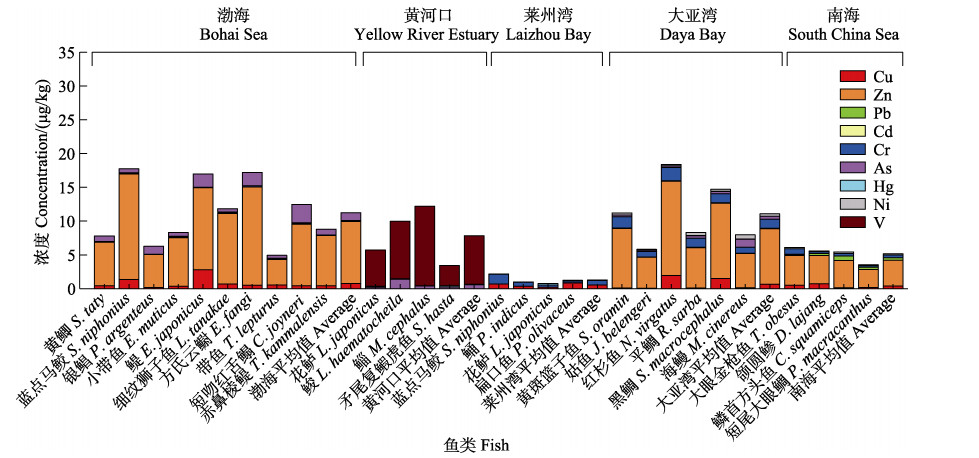
|
图 5 我国不同海区鱼类重金属含量对比 Fig.5 Comparison of heavy metal contents in fish from different sea areas of China |
渤海鱼类重金属单因子污染指数评价结果显示,渤海鱼类污染最严重的重金属为Cd和As,这可能是由于一方面随着环渤海区域经济的快速发展,工业和航运业重金属排放量急剧增加,导致渤海海域Pb、Zn、Cd浓度急剧增加(Duan et al, 2017);另一方面,与历史数据对比,渤海海水和沉积物各类重金属中As元素含量为上升趋势,这与环渤海港口的建设和发展有密切关联(Liu et al, 2023)。
从内梅罗综合污染状况来看,除黄鲫和赤鼻棱鳀为无综合污染外,其余鱼类均受到多种重金属的综合污染。在这些鱼类中,细纹狮子鱼遭受的综合污染最为严重,建议少食或不食用。金属污染指数也表明,蓝点马鲛、细纹狮子鱼和短吻红舌鳎受污染较重。这可能是由于不同鱼类的栖息环境和摄食行为对重金属的生物积累产生了显著影响(蔡深文等, 2017)。蓝点马鲛为肉食性,主要摄食小型鱼类,少量捕食头足类和甲壳类;细纹狮子鱼为底栖肉食性,以底栖动物和浮游动物为主要食物;短吻红舌鳎为底栖类鱼类,主要摄食多毛类和甲壳类,同样属于肉食性。研究表明,肉食性鱼类肌肉中的重金属含量通常高于杂食性鱼类,这是由于肉食性鱼类在食物链中处于较高营养级,重金属能够通过食物链不断吸收和富集在它们的体内(蔡深文等, 2017)。另外,根据Liu等(2023)的研究,渤海表层沉积物中重金属的含量要高于海水中重金属的含量。大多数重金属通常通过底栖食物链传递,因此,底栖类鱼类更容易摄入较多的重金属(Yi et al, 2011)。
3.3 食用安全评价分析DI对每日膳食量有很大参考价值。联合国粮农组织(FAO)和WHO对Zn和Cu的每日最大允许摄入量建议分别为0~500和300~1 000 μg/(kg·bw·d) (JECFA, 1982),Pb、Cd和iAs的每周最大耐受摄入量分别为25、7和15 μg/(kg·bw·w)(JECFA, 1989、2000; JECFA, 2011)。美国国家研究委员会(National Research Council, NRC)对Cr的每日最大允许摄入量为0.83~33.3 μg/(kg·bw·d) (NRC, 1989)。根据本研究评估结果可知,食用渤海所调查的10种鱼类,重金属Cu、Zn、Pb、Cd、Cr和iAs的DI均低于FAO/WHO和NRC所规定的每日最大允许摄入量。即每日适量摄食渤海鱼类健康风险很低,比较安全。
Cu、Zn和Cr作为人体必需元素,参与人体血红蛋白合成、代谢和调节血糖,需要适量摄入;Pb、Cd和iAs为非必需元素,对人体产生渐进性毒性,过多Cd会导致高血压、引起心脑血管疾病、破坏骨钙等,过量Pb会伤害人体脑细胞、造成智力低下痴呆等(Briffa et al, 2020; Zhou et al, 2022)。本研究所有鱼类样本计算得出的THQ值均 < 1,表明摄食渤海鱼类不会对消费者构成重大健康风险。这与Zhang等(2016)对渤海4种鱼类的研究结果是类似的。对于不同种类的重金属,渤海鱼类样本的平均THQ值排序为iAs > Zn > Cr > Cd > Cu > Pb,表明iAs的食用风险值最高,未来可能成为食用鱼类海产品对人体健康具有潜在威胁的元素。当人体摄入过量有毒iAs时,会经血液循环分布至全身,导致皮肤、心、脾和肺等多种器官和组织功能受损,长期暴露高浓度iAs可能导致肿瘤的发生(Briffa et al, 2020)。因此,未来的研究对iAs应该更加关注。
4 结论近年来,重金属在水生生物体内的生物富集已成为备受关注的科学问题。本研究测定了渤海10种鱼类肌肉中重金属的含量,并评估了鱼类重金属污染程度及其对人体食用安全的潜在风险。鱼类肌肉中的重金属浓度从大到小依次为Zn>As>Cu>Cr>Pb>Cd。与其他海区相比,渤海重金属污染程度处于较高水平。从单一重金属污染程度来看,渤海鱼类受重金属Cd和iAs污染较为严重;重金属综合污染状况表明,细纹狮子鱼受重金属综合污染程度最高。对于人体食用健康风险,摄食渤海鱼类带来的重金属每日摄入量均低于FAO/WHO和NRC所规定的最大允许摄入量;10种鱼类单一重金属Cu、Zn、Pb、Cd、Cr和As的THQ和多种重金属THQS均 < 1,表明摄食渤海鱼类不会对消费者构成健康风险。
BRIFFA J, SINAGRA E, BLUNDELL R. Heavy metal pollution in the environment and their toxicological effects on humans. Heliyon, 2020, 6(9): e4691 |
CAI S W, NI Z H, LIU B, et al. Concentration and risk assessment of heavy metals in the main economic fishes from Chishui River. Freshwater Fisheries, 2017, 47(3): 105-113 [蔡深文, 倪朝辉, 刘斌, 等. 赤水河主要经济鱼类重金属含量及风险评价. 淡水渔业, 2017, 47(3): 105-113 DOI:10.3969/j.issn.1000-6907.2017.03.016] |
CHEN L F, CAI X Y, CAO M X, et al. Long-term investigation of heavy metal variations in mollusks along the Chinese Bohai Sea. Ecotoxicology and Environmental Safety, 2022, 236: 113443 DOI:10.1016/j.ecoenv.2022.113443 |
CHIEN L C, HUNG T C, CHOANG K Y, et al. Daily intake of tbt, Cu, Zn, cd and as for fishermen in Taiwan. Science of the Total Environment, 2002, 285(1/2/3): 177-185 |
COPAT C, BELLA F, CASTAING M, et al. Heavy metals concentrations in fish from Sicily (Mediterranean Sea) and evaluation of possible health risks to consumers. Bulletin of Environmental Contamination and Toxicology, 2012, 88(1): 78-83 DOI:10.1007/s00128-011-0433-6 |
DUAN X, LI Y. Distributions and sources of heavy metals in sediments of the Bohai Sea, China: A review. Environmental Science and Pollution Research, 2017, 24(32): 24753-24764 DOI:10.1007/s11356-017-0330-6 |
GAO C M, ZHU X Y, CHU M, et al. Influence of temperature, salinity and pH on Cu, Pb solubility in excess sludge. Journal of Shanghai Ocean University, 2015, 24(6): 880-885 [高春梅, 朱晓芸, 储鸣, 等. 温度、盐度、pH对剩余污泥铜、铅溶出效应的影响分析. 上海海洋大学学报, 2015, 24(6): 880-885] |
GAO X, ZHOU F, CHEN C A. Pollution status of the Bohai Sea: An overview of the environmental quality assessment related trace metals. Environment International, 2014, 62: 12-30 DOI:10.1016/j.envint.2013.09.019 |
GUO X Q, FAN W C, ZHOU W, et al. Determination and risk assessment of heavy metal content in fish in a reservoir in Hubei Province. Proceedings of China Water Conservancy Academic Conference (Volume 6). Zhengzhou: Yellow River Water Conservancy Press, 2022, 5 [郭雪勤, 范文重, 周伟, 等. 湖北某水库鱼体中重金属含量的测定及风险评价. 中国水利学会. 2022中国水利学术大会论文集(第六分册). 郑州: 黄河水利出版社, 2022, 5]
|
HAN D D, ZHAO F, MU W L, et al. Hazard analysis and screening of the prior heavy metals of priority pollution in fish in the Yellow Sea and the Bohai Sea. Progress in Fishery Sciences, 2018, 39(1): 46-53 [韩丹丹, 赵峰, 牟伟丽, 等. 黄渤海鱼类优先监控重金属污染物的筛选与评价. 渔业科学进展, 2018, 39(1): 46-53] |
JECFA (Joint FAO/WHO Expert Committee on Food Additives). Evaluation of Certain Food Additives and Contaminants. WHO Technical Report Series, No. 683. Geneva, Switzerland: World Health Organization, 1982, 31–33
|
JECFA (Joint FAO/WHO Expert Committee on Food Additives). Evaluation of Certain Food Additives and Contaminants. WHO Technical Report Series, No. 776. Geneva, Switzerland: World Health Organization, 1989, 26–35
|
JECFA (Joint FAO/WHO Expert Committee on Food Additives). Evaluation of Certain Food Additives and Contaminants. WHO Technical Report Series, No. 896. Geneva, Switzerland: World Health Organization, 2000, 81–87
|
JECFA (Joint FAO/WHO Expert Committee on Food Additives). Evaluation of Certain Food Additives and Contaminants. WHO Technical Report Series, No. 960. Geneva, Switzerland: World Health Organization, 2011, 149–162
|
LI A S, HOU L. Study of heavy metal contents in seawater, sediments and marine organisms in Qinhuangdao sea area. Coal and Chemical Industry, 2017, 40(3): 157-160 [李安朔, 侯丽. 秦皇岛海域海水和沉积物及生物体中重金属含量的研究. 煤炭与化工, 2017, 40(3): 157-160] |
LI C Y, CUI Z G, BAI Y, et al. Distribution characteristics of heavy metals in recirculating aquaculture system and risk assessment of fish. Environmental Chemistry, 2023, 42(3): 733-742 [李纯毅, 崔正国, 白莹, 等. 循环水养殖系统重金属的分布特征及鱼体风险评估. 环境化学, 2023, 42(3): 733-742] |
LI Y, GUO L, FENG H. Status and trends of sediment metal pollution in Bohai Sea, China. Current Pollution Reports, 2015, 1(4): 191-202 DOI:10.1007/s40726-015-0021-1 |
LIANG X, TIAN C, ZONG Z, et al. Flux and source-sink relationship of heavy metals and arsenic in the Bohai Sea, China. Environmental Pollution, 2018, 242: 1353-1361 DOI:10.1016/j.envpol.2018.08.011 |
LIU H, DING C, ZHANG G, et al. Dissolved and particulate heavy metal pollution status in seawater and sedimentary heavy metals of the Bohai Bay. Marine Environmental Research, 2023, 191: 106158 DOI:10.1016/j.marenvres.2023.106158 |
LIU Y, LIN C, CHEN J M, et al. Distribution and risk assessment of heavy metal in nekton of South China Sea. Marine Environmental Science, 2021, 40(3): 401–406, 416 [刘洋, 林彩, 陈金民, 等. 南海游泳动物重金属含量特征及风险评价. 海洋环境科学, 2021, 40(3): 401–406, 416] |
NRC (National Research Council). Recommended Dietary Allowances. Washington, DC, USA: National Academy of Sciences, 1989, 241–243
|
PAN K, WANG W. Trace metal contamination in estuarine and coastal environments in China. Science of the Total Environment, 2012, 421/422: 3-16 DOI:10.1016/j.scitotenv.2011.03.013 |
RAHMAN M S, MOLLA A H, SAHA N, et al. Study on heavy metals levels and its risk assessment in some edible fishes from Bangshi River, Savar, Dhaka, Bangladesh. Food Chemistry, 2012, 134(4): 1847-1854 DOI:10.1016/j.foodchem.2012.03.099 |
SADEGHI P, LOGHMANI M, FROKHZAD S. Human health risk assessment of heavy metals via consumption of commercial marine fish (Thunnus albacares, Euthynnus affinis, and Katsuwonus pelamis) in Oman Sea. Environmental Science and Pollution Research, 2020, 27(13): 14944-14952 |
SALAM M A, PAUL S C, NOOR S N B M, et al. Contamination profile of heavy metals in marine fish and shellfish. Global Journal of Environmental Science and Management, 2019, 5(2): 225-236 |
STORELLI M. Potential human health risks from metals (Hg, Cd, and Pb) and polychlorinated biphenyls (PCBs) via seafood consumption: Estimation of target hazard quotients (THQs) and toxic equivalents (THQs). Food and Chemical Toxicology, 2008, 46(8): 2782-2788 |
SUN L L, SONG J M, YU Y, et al. Preliminary assessment on heavy metal levels and food risk in 14 economic organisms of the Rongcheng Bay. Oceanologia et Limnologia Sinica, 2018, 49(1): 52-61 [孙玲玲, 宋金明, 于颖, 等. 荣成湾14种海洋经济生物体中的重金属水平与食用风险初步评价. 海洋与湖沼, 2018, 49(1): 52-61] |
SUN W P, LIU X Y, PAN J M, et al. Levels of heavy metals in commercial fish species from the near-shore of Zhejiang Province. Journal of Zhejiang University (Science Edition), 2012, 39(3): 338-344 [孙维萍, 刘小涯, 潘建明, 等. 浙江沿海经济鱼类体内重金属的残留水平. 浙江大学学报(理学版), 2012, 39(3): 338-344] |
USEPA (United States Environmental Protection Agency). Risk-Based Concentration Table. 2016, Available fromhttps://www.epa.gov/sites/production/files/2016-06/documents/master_sl_table_run_may2016.pd
|
WANG W J, YI Y J, ZHANG S H, et al. Study on heavy metals pollution and health risk assessment among different species of fish over the middle and lower reaches of Yangtze River. Water Resources and Hydropower Engineering, 2019, 50(2): 8-13 [王文君, 易雨君, 张尚弘, 等. 长江中下游鱼类重金属污染及健康风险评价. 水利水电技术, 2019, 50(2): 8-13] |
WEI S X. The harm of heavy metal pollution in water body and its control measures. Chemical Engineering and Equipment, 2022(2): 240-242 [魏思翔. 水体重金属污染的危害与防治对策. 化学工程与装备, 2022(2): 240-242] |
XUE F, HUANG K, SU Z J, et al. Analysis and evaluation of amino acids, fatty acids and safety of heavy metals in Cipangopaludina cathayensis. Progress in Fishery Sciences, 2022, 43(1): 180-187 [薛飞, 黄凯, 宿志健, 等. 中华圆田螺氨基酸、脂肪酸营养价值与重金属安全性评价. 渔业科学进展, 2022, 43(1): 180-187] |
YI Y J, YANG Z F, ZHANG S H. Ecological risk assessment of heavy metals in sediment and human health risk assessment of heavy metals in fishes in the middle and lower reaches of the Yangtze River basin. Environmental Pollution, 2011, 159(10): 2575-2585 |
ZHANG G C, SUN J. Environmental pollution status and research progress in Bohai Sea. Environmental Chemistry, 2023, 42(3): 918-930 [张桂成, 孙军. 渤海环境污染现状及研究进展. 环境化学, 2023, 42(3): 918-930] |
ZHANG L, SHI Z, JIANG Z, et al. Distribution and bioaccumulation of heavy metals in marine organisms in east and west Guangdong coastal regions, South China. Marine Pollution Bulletin, 2015, a, 101(2): 930-937 |
ZHANG L, ZHANG L. Contribution of shellfish consumption to lower mercury health risk for residents in northern Jiaozhou Bay, China. Bioinorganic Chemistry and Applications, 2015, b, 2015: 159521 |
ZHANG Y, LU X, WANG N, et al. Heavy metals in aquatic organisms of different trophic levels and their potential human health risk in Bohai bay, China. Environmental Science and Pollution Research, 2016, 23(17): 17801-17810 |
ZHOU W, CAO Q, HONG M, et al. Spatial distribution and risk assessment of heavy metals in seawater and sediments in Jieshi Bay, Shanwei, China. Frontiers in Marine Science, 2022, 9: 1011564 |



